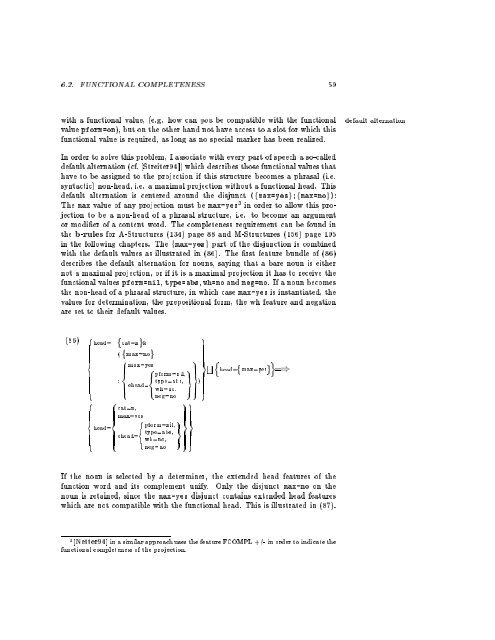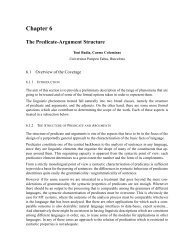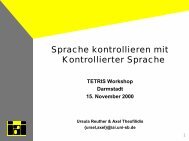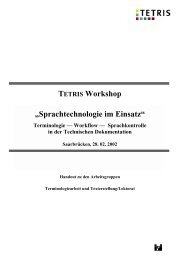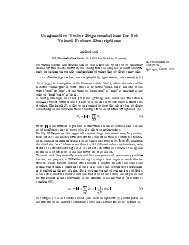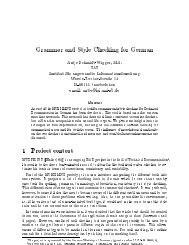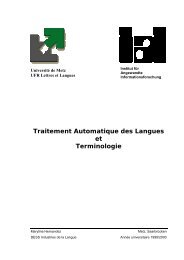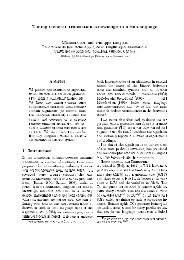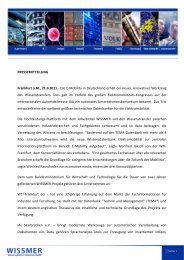Linguistic Modeling for Multilingual Machine Translation
Linguistic Modeling for Multilingual Machine Translation
Linguistic Modeling for Multilingual Machine Translation
You also want an ePaper? Increase the reach of your titles
YUMPU automatically turns print PDFs into web optimized ePapers that Google loves.
6.2. FUNCTIONAL COMPLETENESS 59<br />
with a functional value, (e.g. how canyou be compatible with the functional<br />
value p<strong>for</strong>m=on), but on the other hand not have access to a slot <strong>for</strong> which this<br />
functional value is required, as long as no special marker has been realized.<br />
default alternation<br />
In order to solve this problem, I associate with every part of speech a so-called<br />
default alternation (cf. [Streiter94]) which describes those functional values that<br />
have to be assigned to the projection if this structure becomes a phrasal (i.e.<br />
syntactic) non-head, i.e. a maximal projection without a functional head. This<br />
default alternation is centered around the disjunct (fmax=yesgfmax=nog):<br />
The max value of any projection must be max=yes 3 in order to allow this projection<br />
to be a non-head of a phrasal structure, i.e. to become an argument<br />
or modier of a content word. The completeness requirement can be found in<br />
the b-rules <strong>for</strong> A-Structures (134) page 88 and M-Structures (156) page 105<br />
in the following chapters. The fmax=yesg part of the disjunction is combined<br />
with the default values as illustrated in (86). The rst feature bundle of (86)<br />
describes the default alternation <strong>for</strong> nouns, saying that a bare noun is either<br />
not a maximal projection, or if it is a maximal projection it has to receive the<br />
functional values p<strong>for</strong>m=nil, type=abs, wh=no and neg=no. If a noun becomes<br />
the non-head of a phrasal structure, in which case max=yes is instantiated, the<br />
values <strong>for</strong> determination, the prepositional <strong>for</strong>m, the wh feature and negation<br />
are set to their default values.<br />
(86)<br />
8<br />
head=<br />
cat=n &<br />
<br />
( max=no<br />
>< 8<br />
9 >=<br />
max=yes<br />
F n ><<br />
8 9<br />
< p<strong>for</strong>m=nil,<br />
>= head=<br />
max=yes<br />
=<br />
<br />
type=abs, )<br />
ehead=<br />
>:<br />
>: : wh=no, ><br />
><br />
neg=no<br />
8 8<br />
99<br />
cat=n,<br />
max=yes<br />
>< >< 8 9<br />
>= >=<br />
head= < p<strong>for</strong>m=nil, =<br />
type=abs,<br />
ehead=<br />
>: >: : wh=no, ><br />
><br />
neg=no<br />
9<br />
o<br />
=)<br />
If the noun is selected by a determiner, the extended head features of the<br />
function word and its complement unify. Only the disjunct max=no on the<br />
noun is retained, since the max=yes disjunct contains extended head features<br />
which are not compatible with the functional head. This is illustrated in (87).<br />
3 [Netter94] in a similar approach uses the feature FCOMPL +/- in order to indicate the<br />
functional completeness of the projection.


